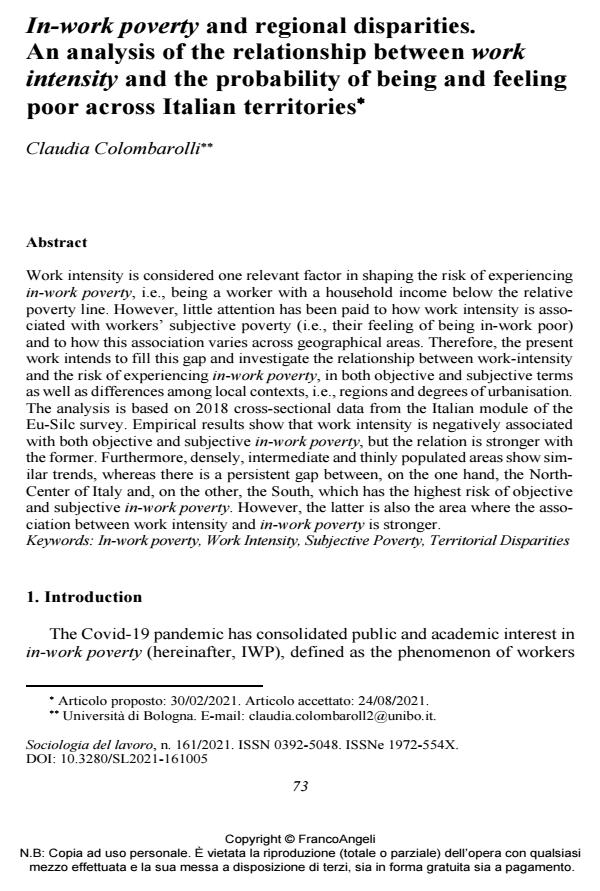In-work poverty and regional disparities. An analysis of the relationship between work intensity and the probability of being and feeling poor across Italian territories
Journal title SOCIOLOGIA DEL LAVORO
Author/s Claudia Colombarolli
Publishing Year 2021 Issue 2021/161
Language English Pages 24 P. 76-93 File size 320 KB
DOI 10.3280/SL2021-161005
DOI is like a bar code for intellectual property: to have more infomation
click here
Below, you can see the article first page
If you want to buy this article in PDF format, you can do it, following the instructions to buy download credits

FrancoAngeli is member of Publishers International Linking Association, Inc (PILA), a not-for-profit association which run the CrossRef service enabling links to and from online scholarly content.
Work intensity is considered one relevant factor in shaping the risk of experiencing in-work poverty, i.e., being a worker with a household income below the relative poverty line. However, little attention has been paid to how work intensity is associated with workers’ subjective poverty (i.e., their feeling of being in-work poor) and to how this association varies across geographical areas. Therefore, the present work intends to fill this gap and investigate the relationship between work-intensity and the risk of experiencing in-work poverty, in both objective and subjective terms as well as differences among local contexts, i.e., regions and degrees of urbanisation. The analysis is based on 2018 cross-sectional data from the Italian module of the Eu-Silc survey. Empirical results show that work intensity is negatively associated with both objective and subjective in-work poverty, but the relation is stronger with the former. Furthermore, densely, intermediate and thinly populated areas show similar trends, whereas there is a persistent gap between, on the one hand, the North-Center of Italy and, on the other, the South, which has the highest risk of objective and subjective in-work poverty. However, the latter is also the area where the association between work intensity and in-work poverty is stronger.
Keywords: In-work poverty, Work Intensity, Subjective Poverty, Territorial Disparities
- Are the in-work poor more disadvantaged in urban areas? An analysis of housing affordability in Italy Claudia Colombarolli, in Housing Studies /2025 pp.1732
DOI: 10.1080/02673037.2024.2369144 - Increasing work intensity to improve economic well-being: an analysis across European countries Claudia Colombarolli, in European Societies /2025 pp.752
DOI: 10.1162/euso_a_00037
Claudia Colombarolli, In-work poverty and regional disparities. An analysis of the relationship between work intensity and the probability of being and feeling poor across Italian territories in "SOCIOLOGIA DEL LAVORO " 161/2021, pp 76-93, DOI: 10.3280/SL2021-161005